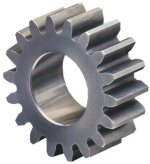ratiofinder.xls

Description
Calculates gear tooth numbers to arrive at a specific ratio. For single or two stage gearing.
Calculation Reference
Machine Design
Calculating gear tooth numbers to arrive at a specific ratio can be done using the following steps:
- Required input parameters:
- Desired gear ratio (R): The ratio between the output speed and the input speed of the gears.
- Minimum number of teeth (Nmin): The minimum number of teeth allowed for the gears. This parameter is usually set to avoid undercutting or other manufacturing issues.
- Maximum number of teeth (Nmax): The maximum number of teeth allowed for the gears, typically determined by size constraints or manufacturing limitations.
- Calculate the gear tooth numbers for single-stage gearing:
For single-stage gearing, the gear ratio (R) is the ratio between the number of teeth on the output gear (N2) and the number of teeth on the input gear (N1):
R = N2 / N1
To find suitable gear tooth numbers for a specific gear ratio, iterate through possible values of N1 and N2 between Nmin and Nmax, and check if the ratio is close enough to the desired ratio R:
- For each N1 in the range of Nmin to Nmax:
- Calculate N2 = R * N1
- Check if N2 is within the range of Nmin and Nmax, and if N2 is an integer or very close to an integer
- If N2 meets the criteria, you have found a suitable gear tooth combination (N1, N2) that results in the desired gear ratio
- Calculate the gear tooth numbers for two-stage gearing:
For two-stage gearing, the overall gear ratio (R) is the product of the gear ratios of each stage:
R = (N2 / N1) * (N4 / N3)
To find suitable gear tooth numbers for a specific gear ratio in a two-stage system, iterate through possible values of N1, N2, N3, and N4 between Nmin and Nmax, and check if the product of the two stage ratios is close enough to the desired ratio R:
- For each N1 and N3 in the range of Nmin to Nmax:
- Calculate N2 = R * N1 * N3 / (N1 + N3)
- Calculate N4 = R * N1 * N3 / (N2 + N4)
- Check if N2 and N4 are within the range of Nmin and Nmax, and if they are integers or very close to integers
- If N2 and N4 meet the criteria, you have found a suitable gear tooth combination (N1, N2, N3, N4) that results in the desired gear ratio
Note that these calculations are based on simple gear ratios and assume that the gears mesh properly. In practice, other factors such as pitch diameters, pressure angles, and tooth profiles need to be taken into account to ensure proper gear functioning.
Calculation Preview
Full download access to any calculation is available to users with a paid or awarded subscription (XLC Pro).
Subscriptions are free to contributors to the site, alternatively they can be purchased.
Click here for information on subscriptions.
